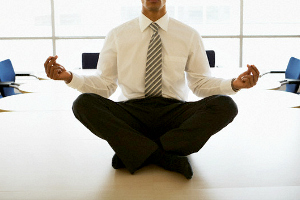A person that regularly meditates can deal with situations in a calm way.
If someone mentioned the word ‘meditation’ to you, you would be forgiven for picturing yourself sitting in a Tibetan temple, palms facing upward in total silence and mouthing traditional ‘Ommmmm’ sounds.
The truth is that not only can meditation be done anywhere and virtually everywhere, but it can also fit into the busy lives of the modern day 9 to 5 professional. Meditation is safe, easy (with a little practice), and benefits not only the mind but the body and if you’re really into it, the soul.
Meditation dates back around 5000 years under the name ‘Tantra’. One of the biggest icons in the history of meditation in both current and times past is the Buddha.

Some of the most popularly used forms today are the Buddhist and Hindu-based, Eastern-style of meditation.
The benefits of meditation to the human body have been scientifically proven over the years. Here are a few health benefits to meditation:
- Anti-inflammatory
- Lowers blood pressure – a common one among us Asians!
- Increased Immunity
- Increased fertility
- Relieves Irritable Bowel Syndrome
- Relieves Anxiety and Depression
So, how does meditation affect your state of mind? Firstly, the history behind meditation and the teachings derived from it suggest that daily meditation can change a person’s outlook on life.

Another way in which meditation can benefit the mind is through modern science. A study conducted by Dr Eileen Luders in the Department of Neurology at the UCLA, shows that meditation can affect the physical structure of the brain using an MRI scan.
In this study, Luders finds several differences between brains of people that meditate daily and brains of people that have never meditated.
The DESI’s Guide on How to Meditate
Practicalities:
There are some things you will need decide such as when and where will you mediate, and what to wear.
The first step is to commit to regular daily practice. It’s hard to sometimes commit to a set time or period especially if you work long hours or have a hectic social life. But taking 5 to 10 minutes out each day to meditate shouldn’t be difficult as long as you make it a regular part of your schedule.
Most people meditate first thing in the morning as it gets them feeling energised and refreshed for the day ahead.
Look for somewhere comfortable to sit, either on the floor, on your bed or on a chair and away from interruptions (make sure your phone is put away. Tweeting while meditating is not multi-tasking). Lastly, wear something loose and comfortable. Keep a timer close by.
Step 1 ~ Settle Yourself
- Sit comfortably with your back straight, hands resting on laps with palms facing upwards.
- Your neck should be relaxed with your chin tucked slightly under.
- You need to commit to meditating for the full time you have set aside so make sure you are comfortable.
Step 2 ~ Deep Breathing
- Soften the muscles around your eyes and forehead, defocus your eyes, and gaze softly into the distance.
- Take a deep breath in through your nose and breath out through your mouth as you close your eyes.
Step 3 ~ Pay Attention to your Breathing
- Observe the rising and falling sensation it creates in your body. Focus on the quality of each breath.
- As you observe, you may find thoughts bubbling up into your mind. It is perfectly okay for this to occur.
- Acknowledge the thought and gently bring your awareness back to your breathing.
Step 4 ~ Enjoy the Calm
- Spend this time enjoying the calmness around you. Allow your mind to just simply be for a while.
- You may experience various feelings within your body as your muscles relax.
- You may experience tingling sensations, numbing sensations, feelings of floating or feeling light.
- These feelings are completely normal and are a sign your body is relaxing.
Step 5 ~ Prepare to Come Back
- When your time is up, slowly bring your awareness to your body.
- Notice the weight of your body on your chair or floor. Notice your hands resting on your lap.
- Notice the calm environment around you.
- When you are ready slowly open your eyes.
Step 6 ~ Keep the Calm
- Be clear about what you are going to do straight after you meditate.
- Whether it’s getting into the shower, having breakfast or leaving for work, make sure you carry this wonderful calmness you have created into your next activity.
- During the day try and recall that feeling of calm and remind yourself what it felt like to have that wonderful feeling of clarity.
It is not uncommon to meditate using a mantra during your breathing. This can be something of your own choice but there are many different varieties already out there that might suit you.
Just remember, that meditation is simply about closing down the mind to external chatter and achieving stillness. Sit back and enjoy being the moment.































































